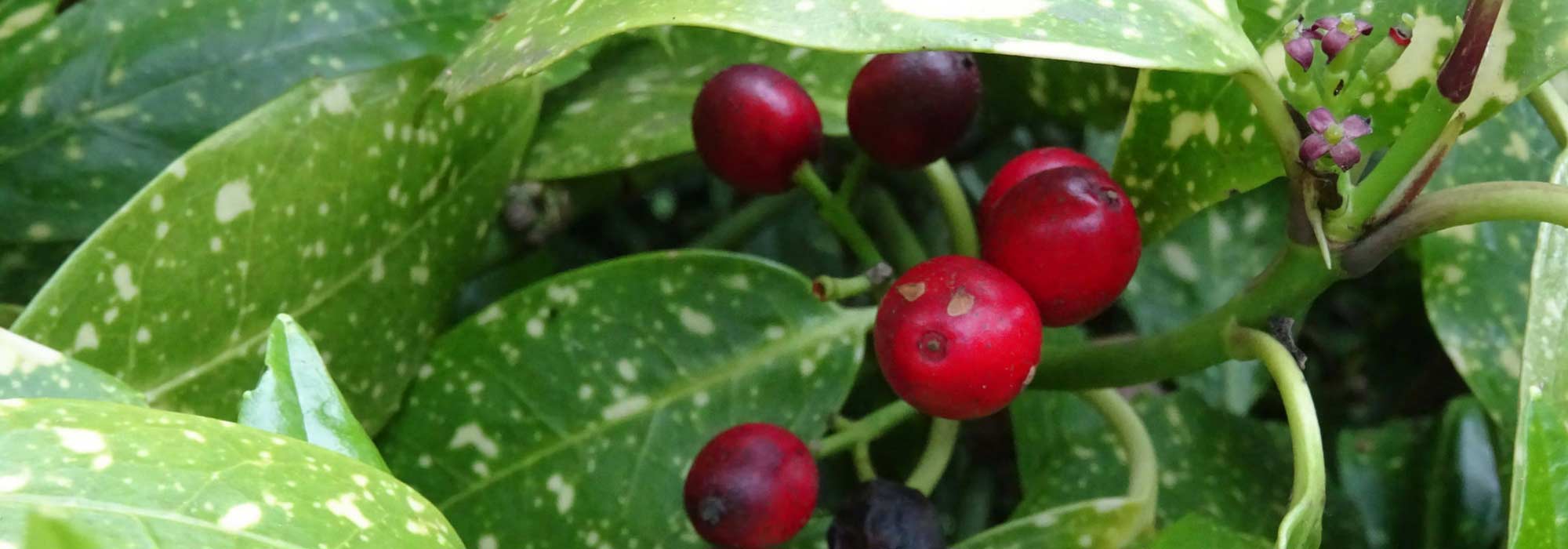
Aucuba: planting, pruning and care
Contents
Aucuba in a nutshell
- Aucuba is an evergreen bush to favour for hedges growing in shade
- Really low-maintenance regarding soil, it thrives in many regions
- It is very resistant to diseases as well as pollution
- Very hardy, it withstands Siberian cold
- It is essential for brightening dark corners in all gardens
A word from our expert
Aucuba or Aucuba Japonica is a compact bush highly valued for its evergreen foliage, either green or variegated, and its red berries in autumn that persist through winter on female plants. Hardy, very robust, resistant to heat, pollution, and diseases, aucuba is one of the most commonly used shrubs in our cities for creating screen hedges.
It is perfect for bringing colour and light to shaded areas of the garden and to north-facing facades.
Praised by gardeners across all our regions for its ability to thrive in any soil, even in dense shade, aucuba tolerates pruning well and quickly forms a compact screen; it is the quintessential shrub for low or high evergreen hedges!
From Aucuba ‘Crotonifolia’ with variegated foliage to Aucuba ‘Rozannie’ with its dark green uniform leaves, Japanese aucuba will find its place in all gardens, as well as on a terrace sheltered from the sun, in the city as well as in the countryside.
Its preference for shaded situations makes it a must-have for brightening up shrub borders in the garden.
Discover our varieties of aucuba, which offer enjoyable ease of cultivation for all gardeners.
Description and Botany
Botanical data
- Latin name Aucuba japonica
- Family Cornaceae
- Common name Aucuba, Japanese Aucuba, Japanese Laurel
- Flowering from March to August
- Height 0.60 to 3 m
- Sun exposure partial shade, shade
- Soil type All, well-drained
- Hardiness -15°C
L’Aucuba or Aucuba japonica, also known as Japanese Laurel, belongs to the Cornaceae family, like its cousin the dogwood. It is a evergreen bush native to the undergrowth of the Far East; from Japan, the Himalayas, and China. The genus includes only 3 or 4 species, all dioecious; only female plants produce fruit, provided they are placed near a male plant.
Only the species Aucuba japonica is cultivated in our regions. It has given rise to numerous cultivars that are distinguished mainly by the colour of their foliage, which can be variegated or spotted, in white or yellow, and by their size at maturity. This dense shrub has a rounded, more or less compact habit and is characterised by a normal to slow growth rate. While Aucuba japonica can reach 5 m in height in its natural habitat, in our climates, its size is more modest. It will eventually form a bush not exceeding 3 m in height with a spread of about 2 m.
It tends to sucker and layer naturally, giving this shrub a beautiful ground cover at maturity.
The Japanese Aucuba is distinguished by its remarkably bright, ample evergreen foliage that lights up the garden throughout the year. The large elliptical to ovate leaves measure 10 to 25 cm in length. Leathery, thick, and glossy, they are arranged in pairs and are generally dentate along the edges. Medium to dark green, like the Aucuba japonica ‘Rozannie’ with its solid foliage, or ‘Longifolia’ with narrow, elongated leaves. They are often abundantly variegated or spotted with bright cream to yellow depending on the varieties. The Aucuba japonica ‘Sulfurea Marginata’ features superb foliage edged in yellow.
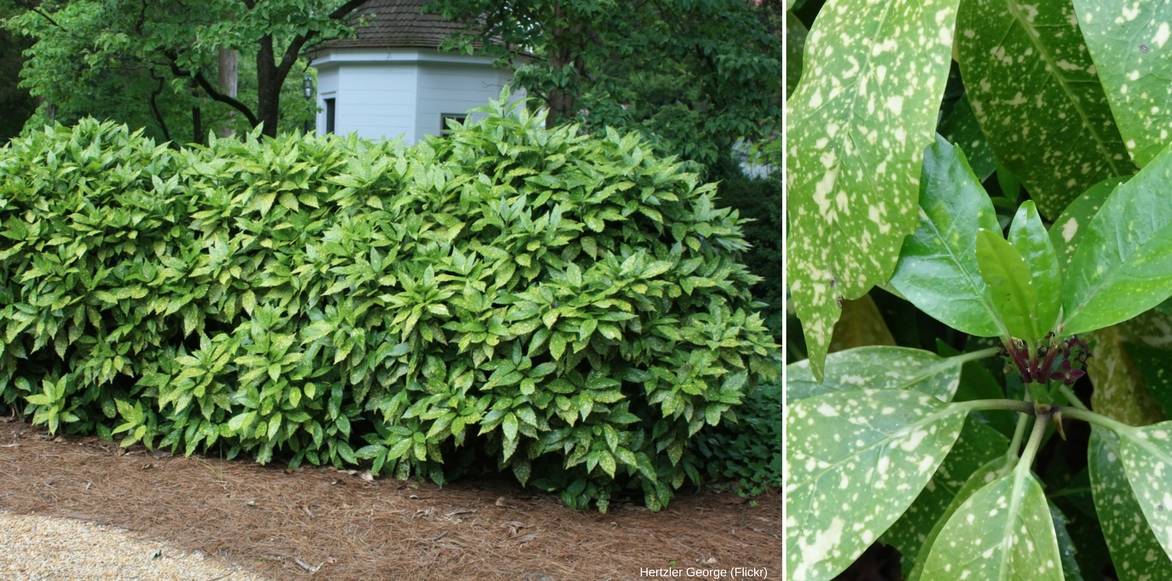
Foliage spotted on some aucubas.
At the end of spring, in April-May, beautiful clusters of small purplish-red flowers appear, hidden by the foliage. Grouped in panicles 10 cm long, the flowers consist of four oval petals.
Provided there are male and female plants side by side, they will give way at the end of summer to early autumn, only on the female aucuba, to lovely clusters of bright red berries, which gradually turn black. Ovoid, they measure 1 to 2 cm in diameter and will persist on the shrub throughout winter until spring. Inedible and toxic to humans, these drupes will, however, delight some birds during the harsh season. Male plants bear yellow anthers.
Very hardy (-15°C), robust, resistant to drought, diseases, pollution, as well as winds and salt spray, Aucuba is a very easy shrub to grow throughout France. The Japanese Laurel grows in any ordinary soil that is not waterlogged and thrives in shaded or partially shaded exposures. Varieties with variegated foliage prefer partial shade, especially in warm climates.
Its decorative, evergreen foliage and great adaptability have made this shrub, very frequently planted in parks and gardens in urban areas, a centrepiece for hedges, but it is also valuable for brightening dark spaces such as the backs of shaded shrub beds, and can be planted alone on a lawn, grown in pots, on a terrace, a balcony, and even indoors.
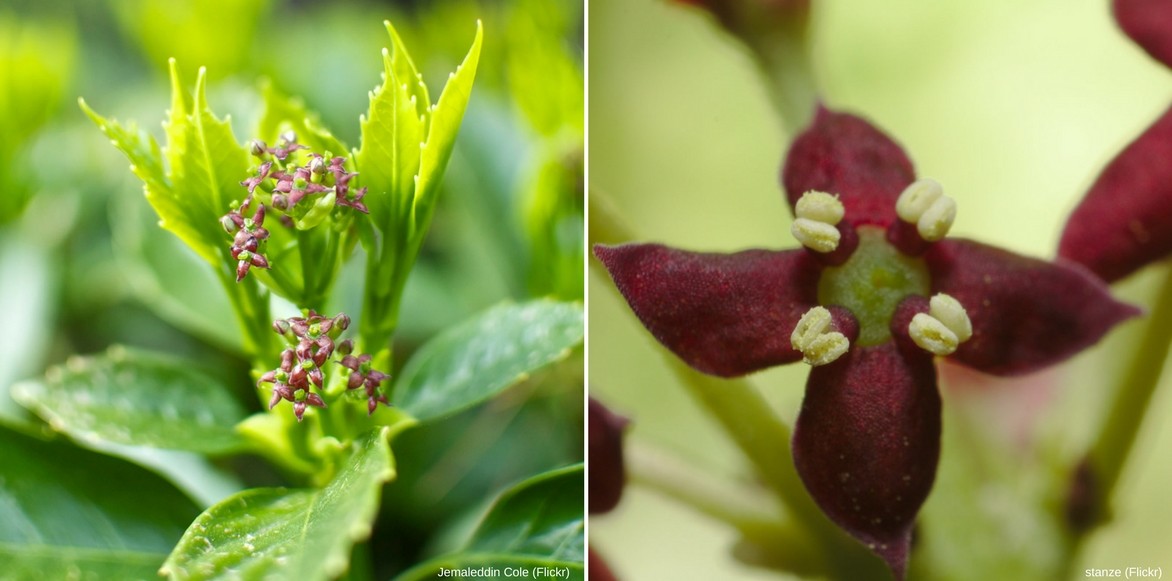
The flowering of aucubas.
Read also
Planting Perennials and BushesMain species and varieties
The Aucuba japonica is the most commonly cultivated species in our gardens. It comes in numerous cultivars with foliage that is sometimes variegated, sometimes spotted, in cream or yellow, which are mainly distinguished by the colour of the leaves and their size ranging from 0.60 cm for dwarf varieties to 3 m in height.
If you wish to see it fruiting, you will absolutely need to plant a male plant near a female plant: in a hedge, do not hesitate to mix the varieties! Aucuba japonica ‘Rozannie’ is a dwarf bisexual form that self-pollinates and also pollinates female Aucubas.
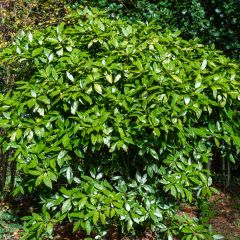
Aucuba japonica
- Flowering time May, June
- Height at maturity 3 m
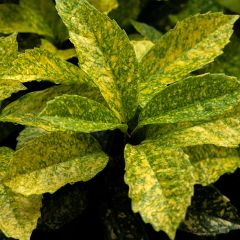
Aucuba japonica Golden King- Spotted Laurel
- Flowering time May, June
- Height at maturity 1,80 m
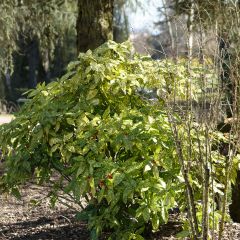
Aucuba japonica Crotonifolia- Spotted Laurel
- Flowering time May, June
- Height at maturity 1,80 m
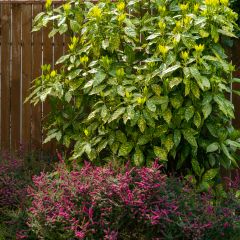
Aucuba japonica Variegata- Spotted Laurel
- Flowering time May, June
- Height at maturity 1,75 m
Discover other Aucuba
View all →Available in 3 sizes
Available in 1 sizes
Available in 1 sizes
Available in 2 sizes
Available in 1 sizes
Planting
Where to Plant Aucuba?
The Aucuba japonica thrives throughout France. With its impressive hardiness, it can withstand very low temperatures down to -15°C, ensuring perfect hardiness in all regions. Its thick, evergreen foliage tolerates urban pollution and sea spray, making it an excellent choice for city gardens where it is abundantly planted, as well as coastal areas. Aucuba does not require much sunlight to grow and prefers a filtered, shaded, or semi-shaded exposure to flourish.
In a Mediterranean climate, it is best to place it in the shade, especially for the variegated forms, which are more sensitive to direct sunlight.
Once well established, Aucuba can withstand short periods of drought and heat. In terms of soil, it is not very demanding, and while it adapts to any good well-drained ordinary soil, it will appreciate rich, acidic, and cool soils as long as they are never waterlogged.
Well-suited to pruning, Aucuba is the quintessential evergreen bush for hedges in all gardens, both in urban and rural settings. It is one of the most commonly used shrubs in cities for creating trimmed hedges, whether low or high. In a low hedge, it provides privacy from unwanted views, while in a high hedge, it forms an excellent windbreak. It can also be used as a standalone specimen on a lawn, left free at the back of a shaded shrub border.
With its dense foliage, it offers a bit of privacy in the shade of porches, balconies, terraces, or even courtyards and patios.
When to Plant Japanese Laurel?
Planting Aucuba is preferably done in spring, in March-April, at the latest until May or in autumn, in September-October, to encourage rooting before winter.
You can reasonably plant until November, avoiding periods of severe frost and extreme heat. In the southern regions of France, you can plant it all year round.
How to Plant Aucuba Japonica?
In the Ground
It prefers cool but well-drained soils where water does not stagnate, especially in winter.
For hedges, depending on the varieties, space the plants about 0.80 to 1 m apart.
- Soak the root ball in a basin of water for 30 minutes
- Remove stones, roots, and weeds from the soil
- Loosen the soil well
- Place your Aucuba in a hole 2 to 3 times larger than the root ball
- In heavy, wet soil, add a good layer of pumice or gravel at the bottom of the planting hole to lighten the soil
- Enrich with a mixture of horticultural compost combined with organic fertiliser or compost
- Plant the shrub at collar level
- Backfill the hole while keeping the shrub upright
- Firm the soil around the base of the plant
- Water thoroughly and then mulch
- Water regularly during the first year after planting
In a pot
The substrate must be very well-draining to avoid moisture stagnating at the roots.
- At the bottom of a container 20 to 30 cm in diameter, spread a good layer of drainage (gravel or clay balls)
- Plant in a good potting mix for shrubs, supplemented with peat and fine perlite
- Place your pot indoors or on a terrace sheltered from direct sunlight
- In summer, water regularly to keep the root ball fresh
- In winter, allow the soil to dry out between waterings
- Apply organic fertiliser during the growing season
→ Read also: Growing Aucuba in a Pot.
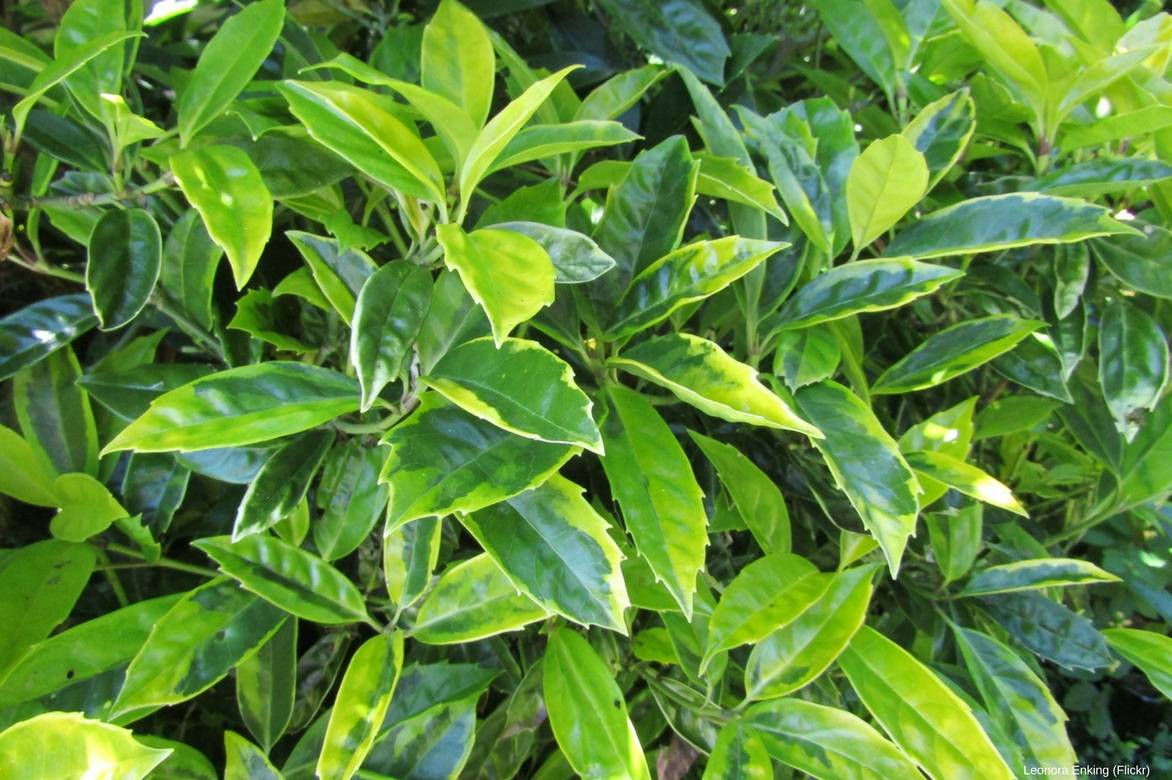
The magnificent foliage of Aucuba japonica ‘Sulphurea Marginata’ brightens up shaded corners.
Read also
Be attentive to evergreen bushesCare
Aucuba requires little care and maintenance. It simply involves monitoring water needs in summer. During the growing season, in the garden, water twice a week. For the rest of the year, Aucuba can be forgotten. In open ground, fertilisation is unnecessary.
For Aucuba in pots, add a liquid fertiliser once a month in summer to enhance its growth. Water sparingly in winter. Allow the soil to dry well between waterings.
When and how to prune an aucuba?
Pruning of Aucuba is not necessary except for those used in hedges. It is done at the end of winter, between February and April. If you prune in autumn, you will miss out on its very decorative berries that persist on the female bush throughout winter.
- For the aucuba planted in isolation, a spring refresh pruning is sufficient to rebalance or reduce the branches: using pruning shears, remove dead or thin wood that disrupts the habit of the aucuba, as well as a few crossing branches to aerate its silhouette. However, this pruning is not necessary every year.
- For those in hedges, pruning can be more regular. Equip yourself with an electric or petrol hedge trimmer for more comfort and prune the tips of the branches once or twice a year. If you wish to reduce its spreading or reshape a subject that is too sparse, you can severely cut back the Aucuba to 30-40 cm from the ground.
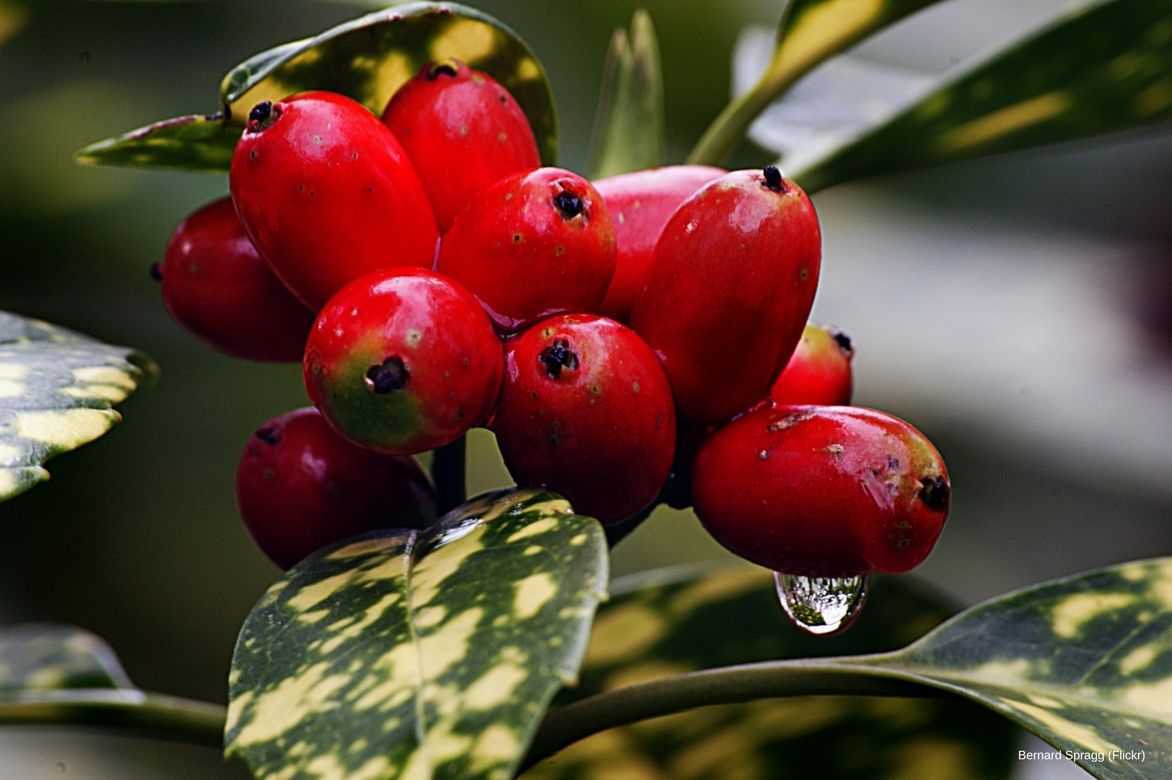
Bright red berries of a female aucuba.
Diseases and potential pests
Aucuba has no enemies and is particularly resistant to diseases and pests. It fears only one thing: waterlogged soils, especially in winter. In poorly drained soil, its leaves may start to fall. Water more moderately in winter.
If the leaves of the Aucuba turn completely black, it is likely too exposed to sunlight. Place it in a spot that is somewhat shaded, away from direct sunlight, especially in regions with hot summers.
In case of an aphid invasion, which can happen, treat with soapy water.
→ Learn more in our advice sheet: How to protect Aucuba from diseases and pests?
Propagation: how to take cuttings of Aucuba?
Aucuba is easily propagated by cuttings. Sowing is possible but remains a long and uncertain method of propagation.
Semi-woody cuttings
Proceed in summer, between mid-July and September.
- Using pruning shears, take stems just below an eye, 10-15 cm long, with a semi-ripe base, meaning it is harder and woody
- Remove the leaves from the bottom of the stem, keeping those at the tips
- Dip the base in plant hormone
- Plant the cuttings in a tray, spacing them 10 cm apart, in a well-draining mix of river sand and potting soil
- Place under a frame or plastic film
- Keep in a room at around 20°C in a substrate kept moist until rooting
- Once well-rooted, gently separate the cuttings and repot them individually in pots filled with potting soil
- Keep protected from frost throughout the winter
- Transplant into the ground the following spring
→ Learn more about propagating Aucuba in Ingrid’s tutorial!
Associating
Aucuba is the essential bush for our gardens, illuminating them throughout the year with its lovely variegated evergreen leaves and bright red berries during winter. It provides a permanent and delightful decor.
A centrepiece for hedges, indispensable in urban gardens, it adapts to all uses: at the back of a shrub border, as a low edging for shorter varieties, isolated, or even in a pot on a terrace or patio.
It pairs well with a multitude of plants that must compete with its shiny, evergreen foliage.
In an evergreen hedge, it harmoniously combines with Cherry Laurel (Prunus laurocerasus Rotundifolia), Portuguese Laurel, False Cypress, or Photinia.
In a free-form hedge or as a backdrop for a shrub bed, it looks great mixed with other evergreens such as Elaeagnus ebbingei, Viburnum tinus, Rhamnus alaternus, Arbutus unedo, Escallonia rubra ‘Crimson Spire’, and Euonymus japonicus ‘Aureomarginatus’.
It plays on contrasts with barberries or even bush or ground-cover roses. In the shade, it is lovely when paired with perennials such as Japanese Anemones, Heucheras, a Dicentra spectabilis Goldheart®, Bergenias, Hostas, and ferns.
You can also pair it with daffodil and tulip bulbs to enhance its foliage in spring.
In Japan, Aucuba is frequently planted in tea gardens, reserved for tea ceremonies. It integrates very well with bamboos, such as Pseudosasa japonica or with Japanese grass and Mahonias for an exotic atmosphere.
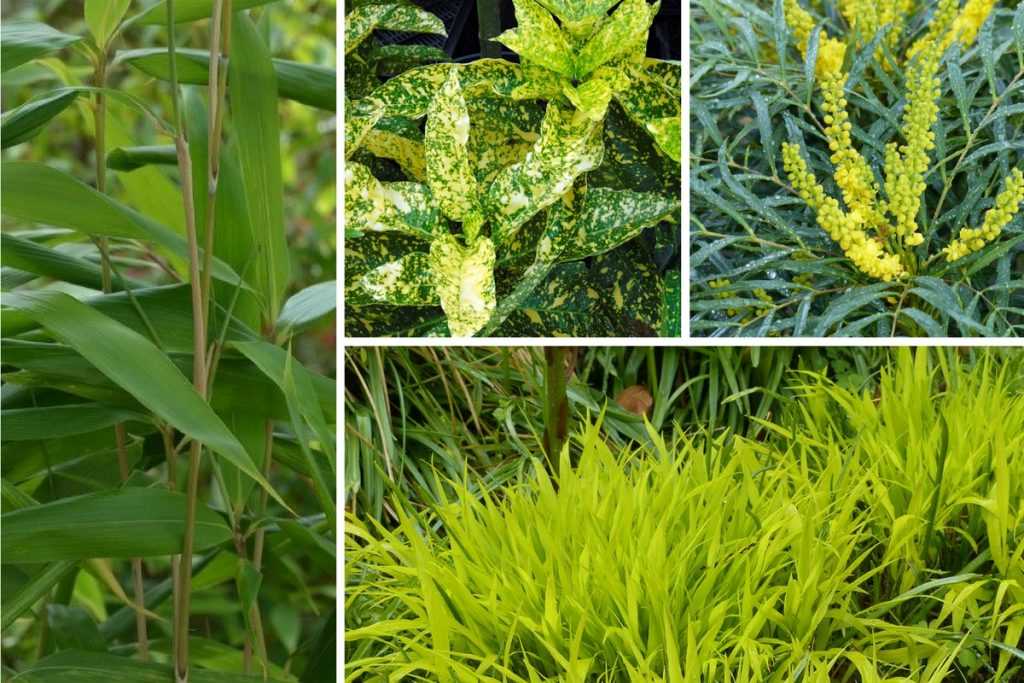
Metake Bamboo Pseudosasa japonica, Aucuba japonica crotonifolia, Mahonia ‘Soft Caress’, and Hakonechloa macra ‘All Gold’
It will bring density and light to a terrace or a semi-shaded entrance alongside a hydrangea, a Mexican Orange, or a Nandina.
→ Discover more association ideas with Aucuba in our advice sheet!
Useful resources
- The most beautiful bushes for hedges are with us!
- Discover our ornamental fruit bushes
- Learn more about propagation by cuttings of Aucuba in Ingrid’s tutorial!
Frequently asked questions
-
My aucuba has black leaves, what is happening?
Aucuba is a versatile bush, very resilient but with a preference for shaded situations, especially in southern regions. Variegated specimens are even more sensitive to excessive sunlight. This is likely due to an overabundance of sun. A few days of intense sunlight and the foliage appears scorched, as black as tar. Place it out of direct sunlight in the shade or partial shade.
- Subscribe!
- Contents
































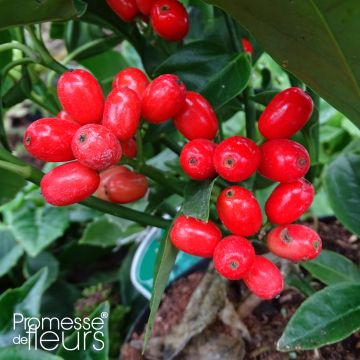



Comments